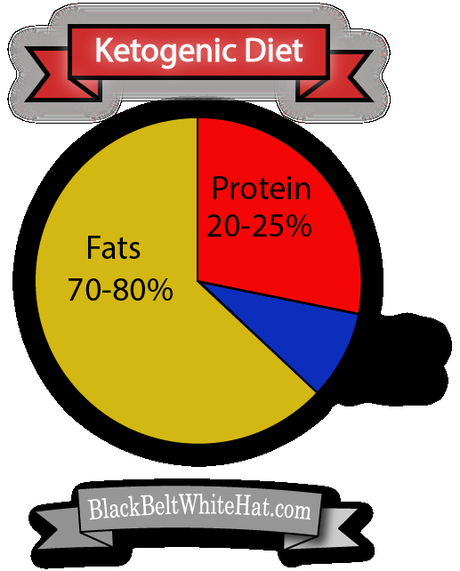Ketogenic diets are becoming more popular – especially in the MMA and weight-loss ‘communities’.
But what is ketosis and what does it do?
What is the Ketogenic Diet?
The ketogenic diet, is a dietary protocol consisting of a low amount of carbohydrate intake, with higher fat and protein intake. Most people who aren’t athletes, eat between 15 & 60g of carbohydrate per day whilst on the ketogenic diet. Eating too many carbs will kick out out of a metabolic state called ‘ketosis’. You can check if you’re in ketosis by using sticks that you pee on.

The History of the Ketogenic Diet
The ketogenic diet has been around for quite some time and it’s not another fad diet. Fasting has been used to treat health conditions since 500 BC (according to available records) and the ketogenic diet was established in the 1920s by physicians as a way to replicate the metabolism of fasting, in order to treat epilepsy in children.
What is Ketosis?
Ketosis your body start utilising ‘ketone bodies’ which are produced by the liver breaking down fatty acids in periods of either fasting, or low carbohydrate intake.
Your body will always use glucose, from carbohydrate-intake as an energy source for the brain and muscles working a higher intensity, when it is available in large enough quantities.
When blood glucose remains low, and can’t be ‘topped’ up from stores in the body (called glycogen), fatty acids are broken down to form acetyl-CoA, which in turn is used in the synthesis of ketone bodies.
Acetyl-CoA is normally used to produce energy from glucose, but can’t in the absence of glucose and oxaloacetate.
It is theorised that your brain could function ‘better’ in ketosis because of the fact that it can yield more energy per gram of ketones, then per gram of glucose.
What are the Ketones / Ketone Bodies
Acetoacetate, beta-hydroxybutyrate, and acetone.
Acetone is formed via the ‘ decarboxylation’ of acetoacetate
What are the Benefits of the Ketogenic Diet?
- Reduced appetite due to steady (low) blood sugar levels
- Lower insulin levels & glucose levels in the blood mean massive reduction in risk of Type 2 diabetes
- Increased mental performance
- Research states that the ketogenic diet is easier to stick to than a low fat diet
- Mounting evidence that the ketogenic diet can fight & prevent most forms of cancer
- Mounting evidence & anecdotes that the ketogenic diet is good for mental health
People who start Keto for mental health issues. How’s being going? from keto
Anxiety and keto from keto
What are the Side Effects of the Ketogenic Diet?
- Maximum power output decreases.
- Fatigue & brain fog in the first 2 weeks
- Bad breath in the first 2 weeks
- Low blood sugar – requires monitoring in the first few weeks due to risk of fainting
The main issue for me is the reduced power output, and reduced exercise capacity at higher intensities.
This can be offset somewhat, in theory, by supplementing creatine, but this doesn’t seem to be that effective.
Tips For Starting a Ketogenic Diet
Start Off Reducing Carbs Slightly
It’s difficult to jump straight into ketosis, if you’ve researched and planned extensively, then you might be able to ignore this, however; most of us are not that organised.
Try keeping your normal 3 meals a day, but snacking exclusively on low-carb foods. Once you’ve found some snacks you like, then look to replace one meal at a time with a ketogenic-friendly, low carb meal.
Check your Macros
Macronutrients – i.e. carbohydrates, fats and proteins (fibre is, strictly speaking a carb that doesn’t, normally, get broken down).
Lots of us are used to estimating or counting calories from normal, high carb foods, but doing the same with fats is very difficult, unless you are used to it. So weigh your foods and get exact calories when you are starting off.
Water Intake
People often run into problems on the ketogenic diet because they don’t drink enough water. Eating a ketogenic diet can make you less thirsty, or in my case, I tend to want hot drinks, rather than water. You may also be eating less food with a high water content such as fruit and therefore need to componsate with a greater water intake.
Electrolyte Intake
Ensure that you are getting enough sodium, potassium and magnesium. Using pink salt on your food and drinking coconut water are the easiest ways of ensuring you are not depleted.
Keto Sweetners
Stevia is the go-to sweetener for many people on a ketogenic diet.
Eat Plenty of Vegetables
Don’t just stick to high fat foods, eat plenty of vegetables for the micronutrients and fiber.
Ketogenic Snacks
Pumpkin seeds
Almonds
Dark chocolate
Hummus and vegetable sticks
Sardines
Eggs

